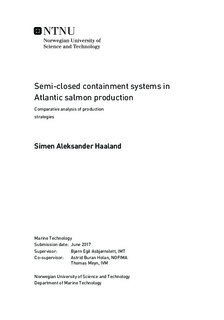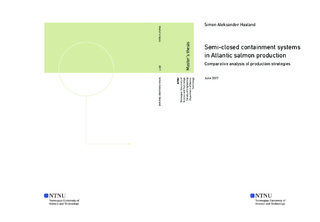| dc.description.abstract | Atlantic salmon farming in Norway are facing huge challenges related to sea lice, mortality and increasing production costs. In the fight against these challenges the Norwegian government are encouraging the industry to develop technological innovations, so it can grow further. Semi-closed containment systems (S-CCS) floating in sea are one of the production systems proposed to face these challenges. Producing Atlantic salmon in S-CCS up to the weight of one kilogram, before transfer to traditional open net pens, has been suggested.
The main difference between a S-CCS compared to a traditional open net pen is the physical barrier that separates the rearing environment from the external environment. This physical barrier also mean that optimal range of rearing parameters like oxygen, CO2, TSS, turbidity, temperature and pH must be ensured by the system. Treatment of intake water and water treatment technology are important to ensure optimal rearing environment.
In this thesis three different production strategies involving production in S-CCS are introduced. Strategy one are based on the suggestion of producing postsmolt up to a weight of one kilogram. Strategy two are including a stage where fish close to market size are moved to S-CCS for the last grow out phase. Strategy three are based on the ongoing development in land based farming. This strategy is including postsmolt production up to a weight of one kilogram in land based systems before the fish are transferred into sea and moved into S-CCS for the last grow out phase. These are the three alternatives in the model.
The Analytic Hierarchy Process (AHP) method are applied to evaluate the alternatives upon the five criteria; Time in sea, Mortality, Cost, Efficiency, Sites and area. The criteria are based on literature and recent research progress. A simple Rank Order Centroid evaluation, applying value functions, were also conducted to compare with the AHP analysis. Sensitivity analysis were performed in the AHP analysis to show the robustness of the results. AHP method favoured strategy one, while the ROC recommended strategy two.
Multiple production strategies and production system will be put into commercial Atlantic salmon production in the years to come. It is likely that these systems will be developed in parallel to exploit the various benefits along the coast. Regulations and constraints will also play an important role in this development. | |

